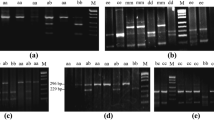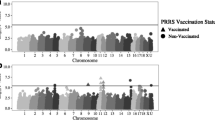Abstract
Porcine reproductive and respiratory syndrome virus (PRRSV), Haemophilus parasuis and Pseudorabies become a widespread problem causing great economic losses associated with reproductive disturbance, respiratory diseases, neonatal mortality, fibrinous polyserositis, meningitis and arthritis in the pig industry. The important candidate genes are assumed to play crucial roles in host defense against the diseases. The aims of this study were to evaluate the variants in HLA-B associated transcript 2 (BAT2), CXCL12, myxovirus resistance protein 1 (Mx1) and EHMT2 genes and their effects on the risk of infection PRRSV and H. parasuis in a case–control (diseased-healthy pigs) population of Duroc × Landrace × LargeWhite. The results showed that the mutations in BAT2, Mx1 and EHMT2 genes were significantly associated with the antibody and the reisk of infection PRRSV and H. parasuis. Those individuals with AA genotype of BAT2 had significantly higher Pseudorabies virus antibody than that with GG and GA (P < 0.05), and the individuals with TT genotype of EHMT2 generated higher Hog Cholera and Pseudorabies virus antibody than that wtih GG and GA (P < 0.01). These results indicated that the polymorphisms in Mx1, BAT2 and EHMT2 genes changed the diseases susceptibility and could be the potential markers assisting the pig breeding selection and disease resistance.

Similar content being viewed by others
References
Rischkowsky B, Pilling D (2007) The state of the world’s animal genetic resources for food and agriculture-in brief. Commission on Genetic Resources for Food and Agriculture, Rome
Stear MJ, Bishop SC, Mallard BA, Raadsma H (2001) The sustainability, feasibility and desirability of breeding livestock for disease resistance. Res Vet Sci 71:1–7
Kelm SC, Freeman AE, Kehrli ME Jr (2001) Genetic control of disease resistance and immunoresponsiveness. Vet Clin North Am Food Anim Pract 17:477–493
Nunes M, Peelman L, Vaiman M, Bourgeaux N, Chardon P (1994) Characterization of six new loci within the swine major histocompatibility complex class III region. Mamm Genome 5:616–622
Langhorne J, Ndungu FM, Sponaas AM, Marsh K (2008) Immunity to malaria: more questions than answers. Nat Immunol 9:725–732
Oh JW, Drabik K, Kutsch O, Choi C, Tousson A, Benveniste EN (2001) CXC chemokine receptor 4 expression and function in human astroglioma cells. J Immunol 166:2695–2704
Lindenmann J, Lane CA, Hobson D (1963) The resistance of A2G mice to myxoviruses. J Immunol 90:942–951
Fang S, Miao J, Xiang LJ, Ponugoti B, Treuter E, Kemper JK (2007) Coordinated recruitment of histone methyltransferase G9a and other chromatin-modifying enzymes in SHP-mediated regulation of hepatic bile acid metabolism. Mol Cell Biol 27:1407–1424
Afshar A, Dulac GC, Bouffard A (1989) Application of peroxidase labelled antibody assays for detection of porcine IgG antibodies to hog cholera and bovine viral diarrhea viruses. J Virol Methods 23:253–261
McCaw MB, Molitor TW, Joo HS (1992) Characterization of pseudorabies virus antibody responses in young swine after infection and vaccination by using an immunoglobulin M antibody capture enzyme-linked immunosorbent assay. J Clin Microbiol 30:346–350
Lü J, Zhao J, Fang L, He Q, Cao S, Chen H (2006) A slide latex agglutination test for the rapid detection of antibodies in serum against porcine parvovirus. J Vet Med B Infect Dis Vet Public Health 53:59–61
Xinglin J, Huanchun C, Qigai H, Xiang W, Bin W, Dexin Q, Liurong F (2002) The development and application of the latex agglutination test to detect serum antibodies against Japanese encephalitis virus. Vet Res Commun 26:495–503
Sambrook J, Fritsch EF, Maniatis T (1989) Molecular cloning: a laboratory manual, 2nd edn. Cold Spring Harbor Laboratory Press, New York
Sole X, Guino E, Valls J, Iniesta R, Moreno V (2006) SNPStats: a web tool for the analysis of association studies. Bioinformatics 22:1928–1929
Wang SJ, Liu WJ, Yang LG, Sargent CA, Liu HB, Wang C, Liu XD, Zhao SH, Affara NA, Liang AX, Zhang SJ (2011) Effects of FUT1 gene mutation on resistance to infectious disease. Mol Biol Rep. doi:10.1007/s11033-011-1039-0
Chen HT, Zhang J, Ma LN, Ma YP, Ding YZ, Liu XT, Chen L, Ma LQ, Zhang YG, Liu YS (2009) Rapid pre-clinical detection of classical swine fever by reverse transcription loop-mediated isothermal amplification. Mol Cell Probes 23:71–74
Nauwynck HJ, Zonnekeyn V, Pensaert MB (1997) Virological protection of sows upon challenge with Aujeszky’s disease virus after multiple vaccinations with attenuated or inactivated vaccines. Zentralbl Veterinarmed B 44:609–615
Rothschild MF, Hill HT, Christian LL, Warner CM (1984) Genetic differences in serum-neutralization titers of pigs after vaccination with pseudorabies modified live-virus vaccine. Am J Vet Res 45:1216–1218
Rothbard JB, Gefter ML (1991) Interactions between immunogenic peptides And MHC proteins. Annu Rev Immunol 9:527–565
Sachs DH, Leight J, Cone J, Schwartz S, Stuart L, Rosenburg S (1976) Transplantation in miniature swine. I. Fixation of the major histocompatibility complex. Transplantation 22:559–567
Wang SJ, Liu WJ, Sargent CA, Zhao SH, Liu HB, Liu XD, Wang C, Hua GH, Yang LG, Affara NA, Zhang SJ (2011) Effects of the polymorphisms of Mx1, BAT2 and CXCL12 genes on immunological traits in pigs. Mol Biol Rep. doi:10.1007/s11033-011-0992-y
Schneidersa A, Thiela S, Winklera J, Möller P, Koch N (2005) Antibodies generated by a novel DNA vaccination identify the MHC class III encoded BAT2 polypeptide. Vaccine 23:2540–2550
Zhang SJ, Jafer O, Yuan JF, Chen HC, Sargent CA, Wu B, Zhou R, Yang LG, Liu H, Wu JJ, Liu HB, Tong Q, Yu Y, Affara NA (2009) Association analysis between pseudorabies antibody and five single-nucleotide polymorphisms in pigs. Animal 3:1363–1367
Lunney JK, Chen H (2010) Genetic control of host resistance to porcine reproductive and respiratory syndrome virus (PRRSV) infection. Virus Res 154:161–169
Kimman TG, Cornelissen LA, Moormann RJ, Rebel JM, Stockhofe-Zurwieden N (2009) Challenges for porcine reproductive and respiratory syndrome virus (PRRSV) vaccinology. Vaccine 27:3704–3718
Mateu E, Diaz I (2008) The challenge of PRRS immunology. Vet J 177:345–351
Haller O, Staeheli P, Kochs G (2007) Interferon-induced Mx proteins in antiviral host defense. Biochimie 89:812–818
Le Bon A, Tough DF (2002) Links between innate and adaptive immunity via type I interferon. Curr Opin Immunol 14:432–436
Samuel CE (2001) Antiviral actions of interferons. Clin Microbiol Rev 14:778–809
Ko JH, Jin HK, Asano A, Takada A, Ninomiya A, Kida H, Hokiyama H, Ohara M, Tsuzuki M, Nishibori M, Mizutani M, Watanabe T (2002) Polymorphisms and the differential antiviral activity of the chicken Mx gene. Genome Res 12:595–601
Morozumi T, Sumantri C, Nakajima E, Kobayashi E, Asano A, Oishi T, Mitsuhashi T, Watanabe T, Hamasima N (2001) Three types of polymorphisms in exon 14 in porcine Mx1 gene. Biochem Genet 39:251–260
Arnheiter H, Skuntz S, Noteborn M, Chang S, Meier E (1990) Transgenic mice with intracellular immunity to influenza virus. Cell 62:51–61
Haller O, Stertz S, Kochs G (2007) The Mx GTPase family of interferon-induced antiviral proteins. Microbes Infect 9:1636–1643
Asano A, Ko JH, Morozumi T, Hamashima N, Watanabe T (2002) Polymorphisms and the antiviral property of porcine Mx1 protein. J Vet Med Sci 64:1085–1089
Palm M, Garigliany MM, Cornet F, Desmecht D (2010) Interferon-induced Sus scrofa Mx1 blocks endocytic traffic of incoming influenza A virus particles. Vet Res 41:29
Zhang X, Shin J, Molitor TW, Schook LB, Rutherford MS (1999) Molecular responses of macrophages to porcine reproductive and respiratory syndrome virus infection. Virology 262:152–162
Arnheiter H, Frese M, Kambadur R, Meier E, Haller O (1996) Mx transgenic mice–animal models of health. Curr Top Microbiol Immunol 206:119–147
Kołacz R, Cwynar P, Filistowicz M (2009) Genetic progress and health implications in swine breeding. Medycyna Wet 65:435–438
Cebrian A, Pharoah PD, Ahmed S, Ropero S, Fraga MF, Smith PL, Conroy D, Luben R, Perkins B, Easton DF, Dunning AM, Esteller M, Ponder BA (2006) Genetic variants in epigenetic genes and breast cancer risk. Carcinogenesis 27:1661–1669
Acknowledgments
We thank farm staffs who help to collect all the related data. Financial assistance from Chinese projects (2009ZX08009-142B, 2008ZX08007-003, S2010GR0947, 2010-Z16), Wuhan project (YJH0044), Grant of Innovation China UK Proof of Concept project (ICUK PoC-RVC-003) is greatly appreciated.
Conflict of interest
The authors have declared no potential conflicts.
Author information
Authors and Affiliations
Corresponding author
Additional information
S. J. Wang and W. J. Liu contributed equally to this study.
Rights and permissions
About this article
Cite this article
Wang, S.J., Liu, W.J., Yang, L.G. et al. Association of multi-pathogenic infections with BAT2, CXCL12, Mx1 and EHMT2 variations in pigs. Mol Biol Rep 39, 8169–8176 (2012). https://doi.org/10.1007/s11033-012-1664-2
Received:
Accepted:
Published:
Issue Date:
DOI: https://doi.org/10.1007/s11033-012-1664-2




